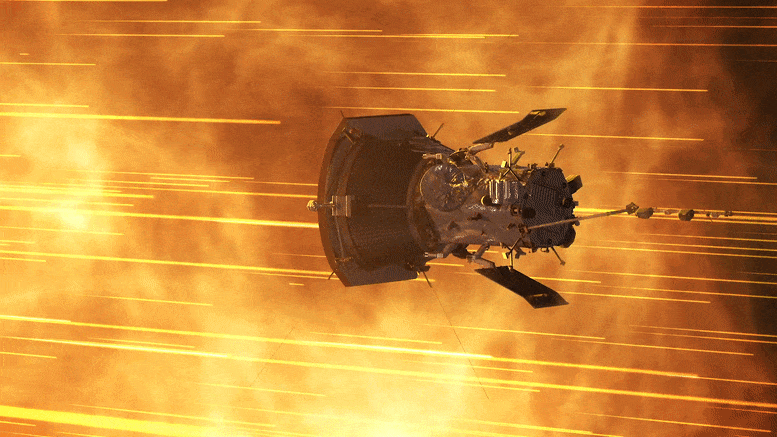
NASA’s Parker Solar Probe (PSP) has detected the origin and structure of the solar wind close to the sun’s surface, observing high-energy particles aligned with flows in coronal holes. This discovery, indicating magnetic reconnection within these regions, improves our understanding and forecasting of solar storms impacting Earth. Credit: NASA GSFC/CIL/Brian Monroe
NASA’s Parker Solar Probe probe got close enough to sun’s surface to see hidden granular features.
NASA’s Parker Solar Probe (PSP) has flown close enough to the sun to detect the fine structure of the solar wind close to where it is generated at the sun’s surface, revealing details that are lost as the wind exits the corona as a uniform blast of charged particles.
It’s like seeing jets of water emanating from a showerhead through the blast of water hitting you in the face.
In a paper published on June 7 in the journal Nature, a team of scientists led by Stuart D. Bale, a professor of physics at the University of California, Berkeley, and James Drake of the University of Maryland-College Park, report that PSP has detected streams of high-energy particles that match the supergranulation flows within coronal holes, which suggests that these are the regions where the so-called “fast” solar wind originates.
Coronal holes are areas where magnetic field lines emerge from the surface without looping back inward, thus forming open field lines that expand outward and fill most of space around the sun. These holes are usually at the poles during the sun’s quiet periods, so the fast solar wind they generate doesn’t hit Earth. But when the sun becomes active every 11 years as its magnetic field flips, these holes appear all over the surface, generating bursts of solar wind aimed directly at Earth.
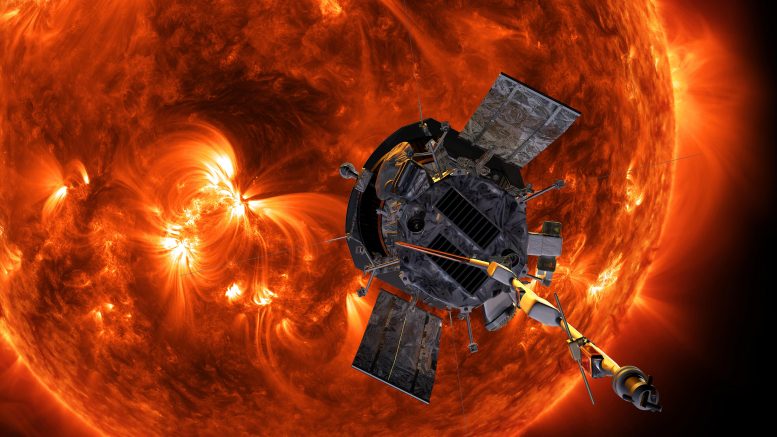
Artist’s concept of the Parker Solar Probe spacecraft approaching the sun. Launched in 2018, the probe is increasing our ability to forecast major space-weather events that impact life on Earth. Credit: NASA/Johns Hopkins APL/Steve Gribben
Understanding how and where the solar wind originates will help predict solar storms that, while producing beautiful auroras on Earth, can also wreak havoc with satellites and the electrical grid.
“Winds carry lots of information from the sun to Earth, so understanding the mechanism behind the sun’s wind is important for practical reasons on Earth,” Drake said. “That’s going to affect our ability to understand how the sun releases energy and drives geomagnetic storms, which are a threat to our communication networks.”
Based on the team’s analysis, the coronal holes are like showerheads, with roughly evenly spaced jets emerging from bright spots where magnetic field lines funnel into and out of the surface of the sun. The scientists argue that when oppositely directed magnetic fields pass one another in these funnels, which can be 18,000 miles across, the fields often break and reconnect, slinging charged particles out of the sun.
“The photosphere is covered by convection cells, like in a boiling pot of water, and the larger scale convection flow is called supergranulation,” Bale said. “Where these supergranulation cells meet and go downward, they drag the magnetic field in their path into this downward kind of funnel. The magnetic field becomes very intensified there because it’s just jammed. It’s kind of a scoop of magnetic field going down into a drain. And the spatial separation of those little drains, those funnels, is what we’re seeing now with solar probe data.”
Based on the presence of some extremely high-energy particles that PSP has detected — particles traveling 10 to 100 times faster than the solar wind average — the researchers conclude that the wind could only be made by this process, which is called magnetic reconnection. The PSP was launched in 2018 primarily to resolve two conflicting explanations for the origin of the high-energy particles that comprise the solar wind: magnetic reconnection or acceleration by plasma or Alfvén waves.
“The big conclusion is that it’s magnetic reconnection within these funnel structures that’s providing the energy source of the fast solar wind,” Bale said. “It doesn’t just come from everywhere in a coronal hole, it’s substructured within coronal holes to these supergranulation cells. It comes from these little bundles of magnetic energy that are associated with the convection flows. Our results, we think, are strong evidence that it’s reconnection that’s doing that.”
The funnel structures likely correspond to the bright jetlets that can be seen from Earth within coronal holes, as reported recently by Nour Raouafi, a co-author of the study and the Parker Solar Probe project scientist at the Applied Physics Laboratory at Johns Hopkins University. APL designed, built, manages, and operates the spacecraft.
Plunging into the sun
By the time the solar wind reaches Earth, 93 million miles from the sun, it has evolved into a homogeneous, turbulent flow of roiling magnetic fields intertwined with charged particles that interact with Earth’s own magnetic field and dump electrical energy into the upper atmosphere. This excites atoms, producing colorful auroras at the poles, but has effects that trickle down into Earth’s atmosphere. Predicting the most intense winds, called solar storms, and their near-Earth consequences is one mission of NASA’s Living With a Star program, which funded PSP.
The probe was designed to determine what this turbulent wind looks like where it’s generated near the sun’s surface, or photosphere, and how the wind’s charged particles — protons, electrons, and heavier ions, primarily helium nuclei — are accelerated to escape the sun’s gravity.
To do this, PSP had to get closer than 25 to 30 solar radii, that is, closer than about 13 million miles.
“Once you get below that altitude, 25 or 30 solar radii or so, there’s a lot less evolution of the solar wind, and it’s more structured — you see more of the imprints of what was on the sun,” Bale said.
In 2021, PSP’s instruments recorded magnetic field switchbacks in the Alfvén waves that seemed to be associated with the regions where the solar wind is generated. By the time the probe reached about 12 solar radii from the surface of the sun — 5.2 million miles — the data were clear that the probe was passing through jets of material, rather than mere turbulence. Bale, Drake, and their colleagues traced these jets back to the supergranulation cells in the photosphere, where magnetic fields bunch up and funnel into the sun.
But were the charged particles being accelerated in these funnels by magnetic reconnection, which would slingshot particles outward, or by waves of hot plasma — ionized particles and magnetic field — streaming out of the sun, as if they’re surfing a wave?
The fact that PSP detected extremely high-energy particles in these jets — tens to hundreds of kiloelectron volts (keV), versus a few keV for most solar wind particles — told Bale that it has to be magnetic reconnection that accelerates the particles and generates the Alfvén waves, which likely give the particles an extra boost.
“Our interpretation is that these jets of reconnection outflow excite Alfvén waves as they propagate out,” Bale said. “That’s an observation that’s well known from Earth’s magnetotail, as well, where you have similar kinds of processes. I don’t understand how wave damping can produce these hot particles up to hundreds of keV, whereas it comes naturally out of the reconnection process. And we see it in our simulations, too. ”
The PSP won’t be able to get any closer to the sun than about 8.8 solar radii above the surface — about 4 million miles — without frying its instruments. Bale expects to solidify the team’s conclusions with data from that altitude, though the sun is now entering solar maximum, when activity becomes much more chaotic and may obscure the processes the scientists are trying to view.
“There was some consternation at the beginning of the solar probe mission that we’re going to launch this thing right into the quietest, most dull part of the solar cycle,” Bale said. “But I think without that, we would never have understood this. It would have been just too messy. I think we’re lucky that we launched it in the solar minimum.”
Reference: “Interchange reconnection as the source of the fast solar wind within coronal holes” by S. D. Bale, J. F. Drake, M. D. McManus, M. I. Desai, S. T. Badman, D. E. Larson, M. Swisdak, T. S. Horbury, N. E. Raouafi, T. Phan, M. Velli, D. J. McComas, C. M. S. Cohen, D. Mitchell, O. Panasenco and J. C. Kasper, 7 June 2023, Nature.
DOI: 10.1038/s41586-023-05955-3


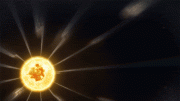
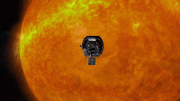
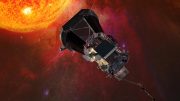
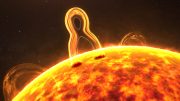
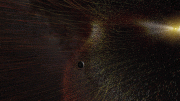

Boil that dust speck.
Boil that dust speck!
Boil That Dust Speck !
BOIL THAT DUST SPECK !
BOIL THAT…
Sorry.